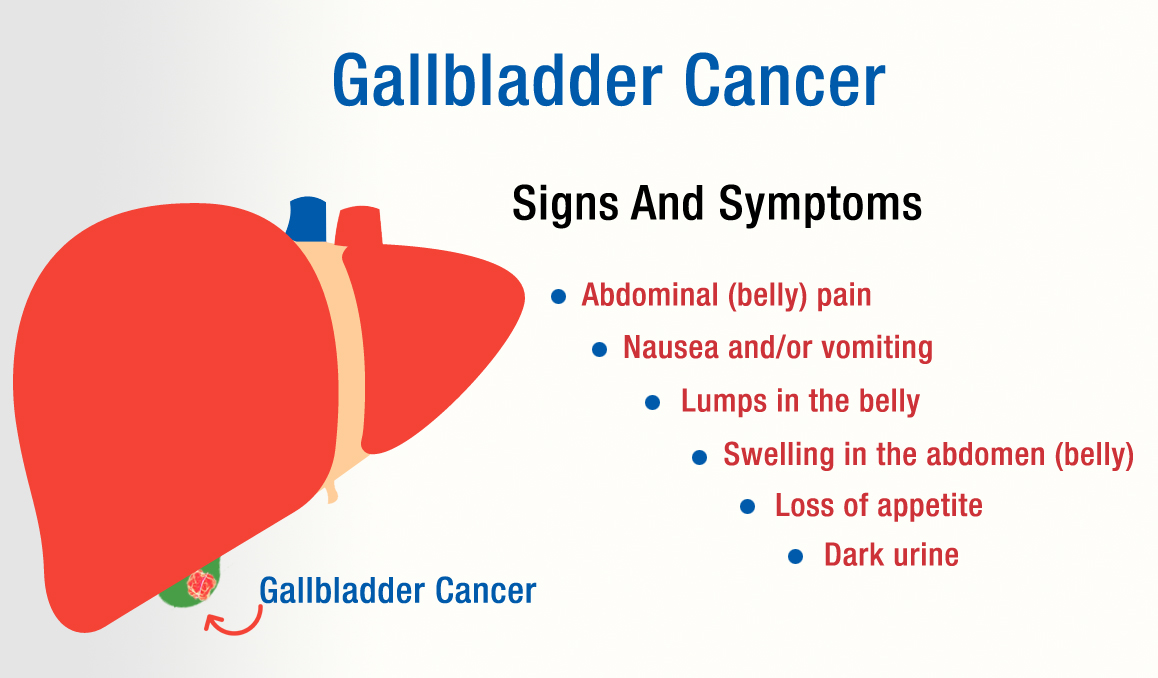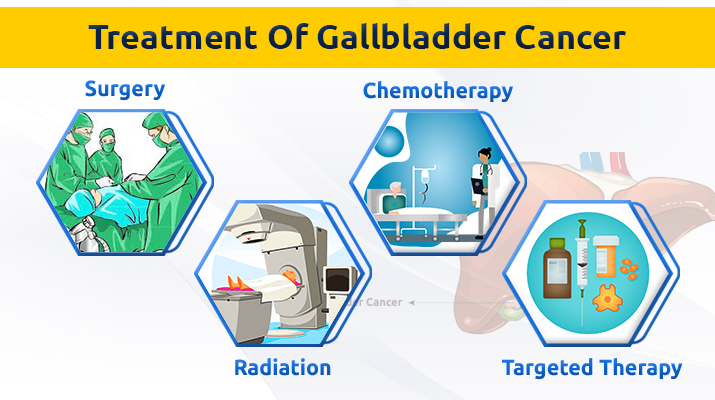Prolife Cancer Centre - Gallbladder Cancer Treatment in Pune
What is Gallbladder Cancer?
The gallbladder is a small, pear-shaped organ under the liver. Both the liver and the gallbladder are behind the right lower ribs. In adults, the gallbladder is usually about 3 to 4 inches long and normally no wider than an inch. Dr. Sumit Shah provides the best Gallbladder Cancer Treatment in Pune at Prolife Cancer Centre which is the best cancer hospital in Pune.

Types of Gallbladder Cancers –
There is more than one type of gallbladder cancer because there are lots of different types of cells in the gallbladder. So if the cancer started in gland cells, it is an adenocarcinoma. If it started in the skin like cells lining the gallbladder, it is a squamous cell cancer, and so on.
- Adenocarcinoma
This is the most common type of gallbladder cancer. More than 85 out of every 100 gallbladder cancers (85%) are adenocarcinomas. The cancer starts in gland cells in the gallbladder lining. These gland cells normally produce mucus (thick fluid).
- Squamous cell cancers
Squamous cell cancers develop from the skin like cells that form the lining of the gallbladder, along with the gland cells. They are treated in the same way as adenocarcinomas.
- Adenosquamous Cancer
Adenosquamous carcinomas are cancers that have both squamous cancer cells and glandular cancer cells. Your doctor might call this a mixed histology. These cancers are treated in the same way as adenocarcinomas.
- Small Cell Cancer
Small cell carcinomas are also called oat cell carcinomas. This is because the cancer cells have a distinctive oat like shape.
- Sarcoma
Sarcoma is the name for a cancer that affects the supportive or protecting tissues of the body, also called the connective tissues. Muscles, blood vessels and nerves are all connective tissues. So a cancer that begins in the muscle layer of the gallbladder is called a sarcoma.
- Neuroendocrine Tumour
Neuroendocrine tumours are rare cancers that grow from hormone producing tissues, usually in the digestive system. The most common type of neuroendocrine tumour is called carcinoid.
What are the symptoms of Gallbladder Cancer ?
Gallbladder cancer signs and symptoms may include:
- Abdominal pain, particularly in the upper right portion of the abdomen
- Abdominal bloating
- Fever
- Losing weight without trying
- Nausea
- Yellowing of the skin and whites of the eyes (jaundice)
Risk factors of Gallbladder Cancer –
Factors that can increase the risk of gallbladder cancer include:
- Your sex – Gallbladder cancer is more common in women.
- Your age – Your risk of gallbladder cancer increases as you age.
- A history of gallstones – Gallbladder cancer is most common in people who have had gallstones in the past. Still, gallbladder cancer is very rare in these people.
- Other gallbladder diseases and conditions – Other gallbladder conditions that can increase the risk of gallbladder cancer include gallbladder polyps and chronic gallbladder infection.

Book Appointment
Quick Contact
- Address 557A1/15C Gultekadi, Market Yard Pune, Maharashtra 411037
- Email social.prolife@gmail.com
- Phone +91-9607079019, +91-9607079029
Tests and procedures used to stage gallbladder cancer
Exploratory surgery. Your doctor may recommend surgery to look inside your abdomen for signs that gallbladder cancer has spread.
Tests to examine the bile ducts. Your doctor may recommend procedures to inject dye into the bile ducts. This is followed by an imaging test that records where the dye goes. These tests can show blockages in the bile ducts.
- Additional imaging tests.Most people with gallbladder cancer will undergo a series of scans to help determine whether the cancer has spread or remains localized. Which scans should be performed vary depending on your circumstances. Common scans include a CT of the chest and abdomen, ultrasonography, and an MRI of the liver.
Stages of gallbladder cancer
- Stage I.At this stage, gallbladder cancer is confined to the inner layers of the gallbladder.
- Stage II.This stage of gallbladder cancer has grown to invade the outer layer of the gallbladder.
- Stage III.At this stage, gallbladder cancer has grown to invade one or more nearby organs, such as the liver, small intestine or stomach. The gallbladder cancer may have spread to nearby lymph nodes.
- Stage IV.The latest stage of gallbladder cancer includes large tumors that involve multiple nearby organs and tumors of any size that have spread to distant areas of the body.
Treatment

What gallbladder cancer treatment options are available to you will depend on the stage of your cancer, your overall health and your preferences.
The initial goal of treatment is to remove the gallbladder cancer, but when that isn’t possible, other therapies may help control the spread of the disease and keep you as comfortable as possible. At Prolife Cancer Center, your Gallbladder cancer treatment is personalized to give the best results, while concentrating on your quality of life. We offer the best Gallbladder Cancer Treatment in Pune.
Surgery for early-stage gallbladder cancer
Surgery may be an option if you have an early-stage gallbladder cancer. Options include:
- Surgery to remove the gallbladder.Early gallbladder cancer that is confined to the gallbladder is treated with an operation to remove the gallbladder (cholecystectomy).
- Surgery to remove the gallbladder and a portion of the liver.Gallbladder cancer that extends beyond the gallbladder and into the liver is sometimes treated with surgery to remove the gallbladder, as well as portions of the liver and bile ducts that surround the gallbladder.
Treatments for late-stage gallbladder cancer
Surgery can’t cure gallbladder cancer that has spread to other areas of the body. Instead, doctors use treatments that may relieve signs and symptoms of cancer and make you as comfortable as possible.
Options may include:
- Chemotherapy is a drug treatment that uses chemicals to kill cancer cells.
- Radiation therapy.Radiation uses high-powered beams of energy, such as X-rays and protons, to kill cancer cells.
- Clinical trials.Clinical trials are studies testing experimental or new medications to treat gallbladder cancer. Talk to your doctor to see whether you’re eligible to participate in a clinical trial.
Your time with your doctor is limited, so preparing a list of questions will help you make the most of your time together. List your questions from most important to least important in case time runs out. For gallbladder cancer, some basic questions to ask your doctor include:
- What is my stage of gallbladder cancer?
- Can you explain the pathology report to me? Can I have a copy of my pathology report?
- Will I need more tests?
- What are the treatment options for my gallbladder cancer?
- What are the benefits and risks of each option?
- Is there one treatment option you recommend over the others?
- What would you recommend to a loved one in my same situation?
- Should I get a second opinion from a specialist? What will that cost, and will my insurance cover it?
- Are there any brochures or other printed material that I can take with me? What websites do you recommend?
Statistics
This year, an estimated 12,360 adults (5,810 men and 6,550 women) in the United States will be diagnosed with gallbladder and other biliary cancers. About 4 out of 10 are specifically gallbladder cancers.
It is estimated that 3,960 deaths (1,610 men and 2,350 women) from gallbladder and other biliary cancers will occur this year.
The 5-year survival rate tells you what percent of people live at least 5 years after the cancer is found. Percent means how many out of 100. The 5-year survival rate for people with gallbladder cancer is 19%. However, the survival rate depends on several factors, including the location of the cancer and where it has spread

